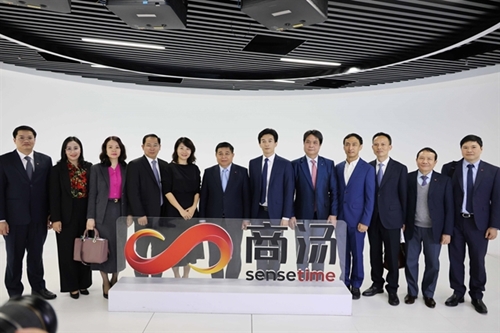Deputy PM Dung, who made a working trip to China from March 18 to 20, had meetings with Guangdong Executive Vice Governor Zhang Hu, Deputy Director of the provincial Development and Reform Commission Zhu Wei, and Executive Vice Mayor of Shenzhen city Tao Yongxin.
    |
 |
|
Deputy Prime Minister Nguyen Chi Dung and his delegation visit the Shenzhen Bay Ecological Science and Technology Park. |
He also visited the Shenzhen University Special Economic Zone Research Centre, the Shenzhen Bay Ecological Science and Technology Park, and the Shenzhen Innovation and Investment Group.
At his meeting with Zhang Hu, Dung congratulated Guangdong on its impressive economic achievements, highlighting its position as the biggest economy among Chinese localities for 36 consecutive years. In 2024, Guangdong’s gross regional domestic product (GRDP) reached nearly 2 trillion USD, making it a symbol of China's reform and opening-up policy.
He praised the positive and comprehensive development of the Vietnam – China relations, emphasising the enhanced political trust, growing economic, trade, investment and tourism ties, along with vibrant people-to-people exchanges.
As Vietnam pursues its centenary development goals for 2030 and 2045, it is focused on making strategic breakthroughs in tandem with promoting digital transformation, science and technology, private sector growth, and apparatus streamlining, he said, expressing the country’s interest in learning from China’s policies and experiences, particularly Guangdong's, on improving the investment climate, developing the private sector, and advancing new economic models such as free trade zones and high-tech parks.
For his part, Zhang highlighted the deep-rooted friendship and historical ties between the two countries. He acknowledged the significant role of Guangdong’s private sector, which contributes to 50% of the GRDP, 60% of trade, 70% of innovation, 80% of jobs, and 90% of businesses in the province.
Sharing the locality's experiences, Zhang emphasised that Guangdong remains steadfast in two key principles – strengthening and developing the state-owned economic sector while simultaneously encouraging, supporting, and guiding the growth of the non-state sector.
The host expressed confidence in the future of the Vietnam – China relations under the leadership of Party General Secretary and President of China Xi Jinping and Party General Secretary of Vietnam To Lam. He affirmed Guangdong’s wish to further strengthen ties with Vietnamese partners, enhance investment cooperation, integrate supply chains, and develop infrastructure and transport projects based on mutual benefit.
Deputy PM Dung welcomed investments from Chinese enterprises, particularly Guangdong ones, in Vietnam. He stressed that cooperation should go beyond capital investment to include technology transfer, management expertise, and high-quality workforce training, especially for key transport projects, innovation centres, big data, semiconductor, and artificial intelligence (AI).
Calling for expanded cultural exchanges and tourism promotion, he also expressed gratitude to Guangdong for preserving the historical site of the Vietnam Revolutionary Youth League headquarters, which helps educate younger generations about the long-standing ties between the two nations.
During the working session with the Guangdong Development and Reform Commission, Dung sought insights on private sector development, economic zone policies, talent attraction strategies, and business-friendly regulations.
Zhu Wei, Deputy Director of the commission, reaffirmed China’s consistent support for the private sector's development and shared Guangdong’s experiences in regulatory reforms, administrative innovation, and SME support.
Zhu noted a growing interest among Chinese enterprises in investing in ASEAN, particularly Vietnam. He emphasised Guangdong’s hope to strengthen economic, trade, and infrastructure partnerships with Vietnamese localities.
Dung welcomed these initiatives, reaffirming Vietnam’s support for deeper cooperation between ministries, sectors, and localities of both countries.
Source: VNA